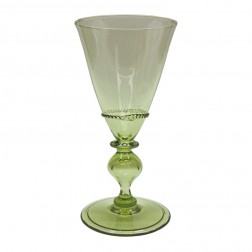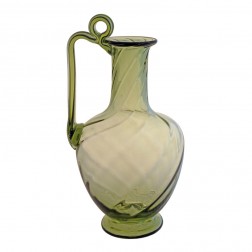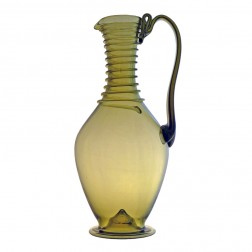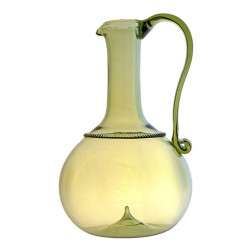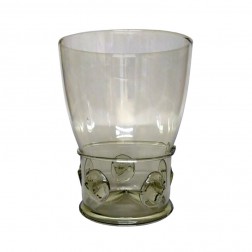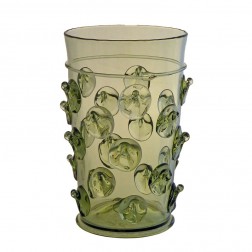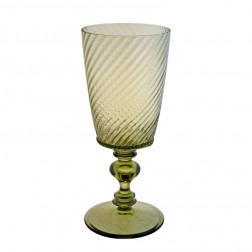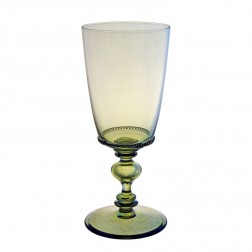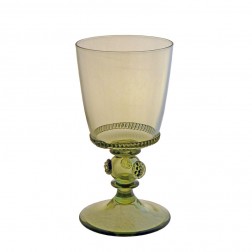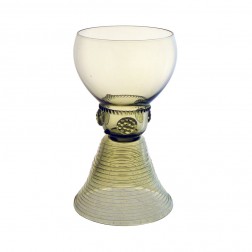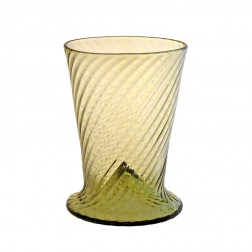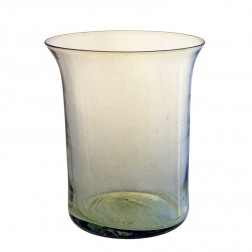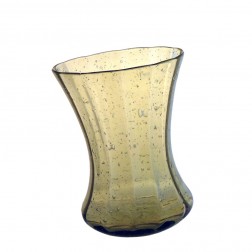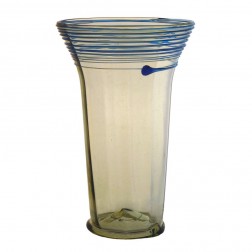-
Venetian wine glass with wreath and nodus
39.95€Drink festively from this wine glass like at a baroque Venetian banquet, Italy. 17th century.
Height of glass 15 cm
Learn More
-
Roman jug
39.95€During the middle of the first century, artisans, presumably in a workshop near Jerusalem or Sidon, made a groundbreaking invention that was to remain determinant for the next 2,000 years: to produce glass hollow bodies by blowing. The Roman jug has a spherical body with rib structure. The upper end of the handle is provided with a thumb plate for better handling. Such pitchers were part of the tableware of Romans from privileged social classes. 3rd century.
Height of glass 22 cm
Learn More
-
Roman jug with handle
49.96€Slim carafe from Roman times. The neck is decorated with a spiral decorated thread. The upper end of the handle is provided with a thumb plate for better handling. 3rd century.Height of glass 22 cm
Learn More
-
Renaissance decanter
69.95€Bellied decanter with attached handle from the Renaissance period. On the shoulder, the vessel is decorated with a notched string of thread. 16th century.
Height of glass 16 cm
Learn More
-
Luther's drinking glass
35.01€This glass was reconstructed on the basis of current archaeological finds during excavations in Luther's residential building in Wittenberg. Guests at the House of Luther: Lucas and Barbara Cranach, Philip Melanchthon, Thomas Müntzer, Johannes Bugenhagen and Georg Spalatin. These and many other contemporaries, together with Katharina and Martin Luther, certainly drank wine from glasses in exactly this form. 16th century.
Height of glass 10 cm
Learn More
-
Krautstrunk
39.95€The most important late medieval glass form came to its name as the glass with its attached nubs reminded of a white cabbage stalk. The name Krautstrunk was already used in 1562 by the Wittenberg pastor Johann Mathesius in his "Glass Sermon". Glasses of this shape were also found near altars, so it should be emphasized that they were also used in the church rite - for altar wine or as a glass reliquary. The attached nubs were meant as decorational elements as well as to provide a secure grip. The attachment of liquid glass gobs has been known since ancient times. 15th century.
Height of glass 13.2 cm
Learn More
-
Renaissance glass with wreath
39.95€This Renaissance glass on a high stand came in fashion from Venice - the tradition-rich glassmaker's center on the Mediterranean, and it is the still common form of our modern wine glasses. Glasses in the this style lie very well in the hand and shine princely. 16th century.
Height of glass 17 cm
Learn More
-
Renaissance glas with wreath
39.95€This Renaissance glass on a high stand came in fashion from Venice - the tradition-rich glassmaker's center on the Mediterranean, and it is the still common form of our modern wine glasses. Glasses in the this style lie very well in the hand and shine princely. 16th century.
Height of glass 17 cm
Learn More
-
Renaissance glass with wreath
39.95€This Renaissance glass on a high stand came in fashion from Venice - the tradition-rich glassmaker's center on the Mediterranean, and it is the still common form of our modern wine glasses. Glasses in the this style lie very well in the hand and shine princely. 16th century.
Height of glass 13.5 cm
Learn More
-
Römer
39.95€The 'Römer' glasses with their bulbous shape are a glass form that has been popular since the Middle Ages until today. The ribbed foot of the glass is decorated with beautiful berry elements. Glasses of this type are shown in numerous still lifes. 18th century.
Height of glass 12.5 cm
Learn More
-
Early Baroque Glass with spiral effect
19.96€Conically shaped ribbed cup with optical spiral effect and a high-cut bottom. To produce this effect, the glass bubble is blown into a patterned shape. The pattern structure then remains when the glass is inflated. This is a form of ornamentation practiced since Roman times. 17th century.
Height of glass 9.5 cm
Learn More
-
Goethe's drinking glass
14.95€The model for this glass stems from Johann Wolfgang von Goethe's private collection and can be viewed today in the Goethe National Museum in Weimar. Goethe probably brought this drinking glass along from one of his journeys to Bohemia. Replicas like this are still made today in traditional handwork in Bohemia and Thuringia.
Height of glass 9,5 cm
Learn More
-
Sturzbecher
24.95€This type of tumbler, also called gobelet caréné, has been used in noble circles since the Merovingian period. These glasses with convex shaped bottom - hence the other name Wackelbecher - were emptied in one go and then "overturned" on the table. This way you could prevent poison from entering the cup during a banquet. The glass for the thirsty! 5th-8th century
Height of glass 10.5 cm
Learn More



